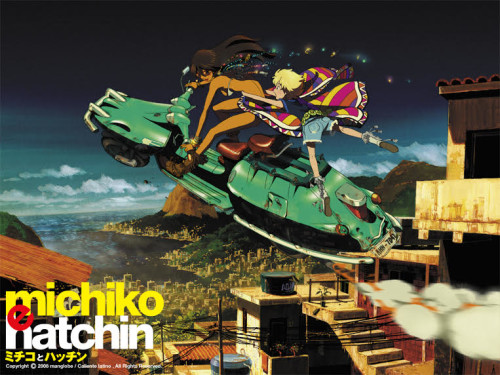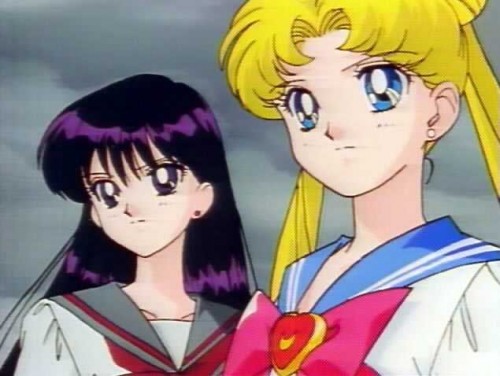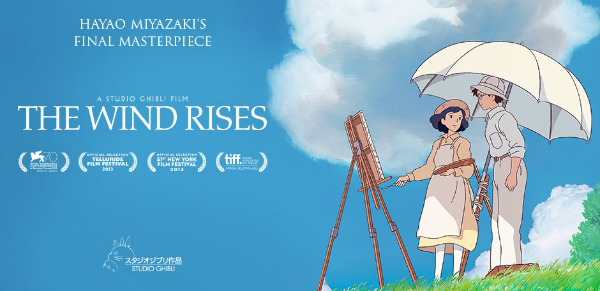This guest post by Robert V. Aldrich appears as part of our theme week on Bad Mothers.
**Includes extremely mild spoilers**
Michiko is a terrible, terrible mom.

In 2008’s Michiko to Hatchin, brought to us by Studio Manglobe and directed by Sayo Yamamoto, we see Michiko Malandro (voiced by Yoko Maki or Monica Rial, depending on the original or English dubbing) break out of prison and liberate her daughter, Hatchin Morenos (voiced by Suzuka Ohgo or Jade Saxton) from an abusive foster family, and subsequently take her daughter on a whirlwind trip around a South American nation that’s totally not Brazil. Sounds like pretty good mom, right?
Yeah, no. See, for starters, Hatchin’s name is actually Hana. Michiko just calls her Hatchin because it seems more fitting. And she isn’t taking Hatchin on this “tour” of South America; she’s on the run from the police (remember the part of her breaking out of prison?). And she isn’t quite so much reuniting her family as she is trying to track down clues to find Hatchin’s allegedly dead father, Hiroshi.
But at least Michiko rescues Hatchin, right? Well, yes, she does do that. But that’s about all she really does for Hatchin. And, again, it’s more because Hatchin might have a clue or two about Hiroshi’s whereabouts. Throughout the course of the 22-episode series, Michiko abandons Hatchin to get laid, lets Hatchin work a part-time job rather than pay for shoes she herself stole, leaves Hatchin with an abusive orphanage (more on that in a second), lets her run away half a dozen times, all while the two bicker constantly about often incredibly petty matters. All of this rolls up to establish that Michiko is, well, basically just a terrible, terrible mom.

And that’s pretty amazing.
Why? Because mothers in anime are usually perfect. Like their fairy tale counterparts, mothers are (with a few very rare exception) saintly figures capable of doing no wrong. The matrons of anime families are often paragons of the traditional Japanese ideal; dedicated homemakers who are happy to don the apron and attend to the culinary and domestic responsibilities of husband and child. Examples include Trisha Elric from Full Metal Alchemist, Ikuko Tsukino (Serena/Usagi’s mother) from Sailor Moon, and even Mom Racer (from Speed Racer), and that’s just the tip of the iceberg. Other characters in anime can be louts but when maternity is concerned, there’s rarely much messing around.
We see atypical examples of course, such as Yui Ikari from Evangelion, who instead of being a homemaker is a brilliant and innovative scientist but whose primary if not sole motivation is to make a better world for her son, Shinji. We see Chi-chi from Dragon Ball Z, who is a ferocious fighter but still the doting housewife. We also see evidence of the strong maternal instinct in non-mother characters, such as the career military woman Lisa Hayes in Robotech/Macross, who adopts a maternal role to Rick Hunter/Hikaru Ichijyo), despite the personal and romantic tension between them.
The anime genre is positively lousy with iconic mothers whom fill the role either perfectly or cleverly. Still, one constant in all of anime is that the role of the mother is filled as near-perfect: in deed or at least intention.
Except Michiko. She’s terrible.

Mothering is hard and not every woman takes to it naturally, even when they’ve hoped to be mothers their entire lives. Check out this clip from Scrubs or episode 11 from the third season of House of Cards (where the campaigning Claire Underwood talks to the lonely mother and wife) just for a few examples in fiction. And yet in anime (like much of art), mothers are often depicted as flawless in their pursuit and intentions, if not results as well. The idea of a woman who isn’t naturally inclined towards maternity, if not automatically great at it, is almost alien and so rare as to be almost be unheard of. Thus art isn’t always imitating life.
Michiko, as outlandish and flamboyant as she is (we first meet her when she drives a motorcycle through a window onto a dinner table), might be one of the most realistic depictions of motherhood in anime. Not because she’s terrible per se, but because mothering doesn’t come naturally to her. At all. It’s not some magical transformation that she (like all women) automatically goes through. Some women struggle with the trials and with not knowing what to do. Some fail at it, no matter how much they wished they could do better. And Michiko reflects that possibility.
Of course, Michiko isn’t the only mother in the series. On the contrary, the series has quite a few mothers and mother-figures. In episodes five and six, we meet the woman who ran the orphanage that Mitchiko grew up in, Zelia Bastos. A hard woman, we see her making a terrible situation almost functional. She’s a horror, but a horror found in a horrible world. We see a menagerie of mother-figures, but almost none are actual biological and true-to-the-iconic-image of the mother-saint found in so many other anime. Whether it’s a drag-queen single father doing his best or even Hatchin having to take care of her ill mother, motherhood as both a responsibility and an identity is an undercurrent in Michiko to Hatchin and nobody is the ideal.

The series does a lot to explore the different people in Michiko’s life, and by virtue Hatchin’s life as well. We see a multitude of different maternal figures, including, at the very end, Hatchin herself. The series closes by jumping forward half a dozen years to when Hatchin works as a cook and has a child of her own, a little baby girl. Her life is far from idyllic but it’s a life of her own creating and one free of at least some of the troubles that plagued her own mother. In some ways, her life is the result of Michiko’s trials and struggles witnessed throughout the show. Just as Michiko tried to give Hatchin a better life than she had (which she did, which is a testament to how terrible Michiko’s life was), Hatchin tries to give her daughter a better life than she. And she seems to be managing it, certainly at least compared to Michiko’s efforts.
The series, directed by Sayo Samamoto (previously known for her work on Trava: Fist Planet and Samurai Champloo) and produced by Shinichiro Watanabe (one of the leading voices in modern anime, with credits like the aforementioned Samurai Champloo as well as Cowboy Bebop and segments from the Animatrix), isn’t the most innovative or ground-breaking anime narrative to come along, but it is most certainly a breath of fresh air. It is a vibrant and encouraging show with a vivid style and a unique feel. It can remind palling anime fans of what the medium can do and it’s the sort of thing that can surprise others who might dismiss anime as nothing but “giant robots and hentai.” This is a great show that deviates from so many anime norms, but its greatest accolade may just be its bravery to make Michiko a terrible, terrible mother.

Robert V Aldrich is a semi-talented author who writes novels and others works, while also speaking at conventions. His newest novel, Samifel, will be released by Haven Publishing House this June at Anime Mid-Atlantic. His writings and other works are available at official website, TeachTheSky.com














